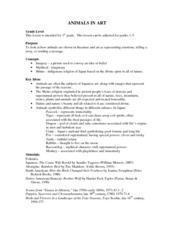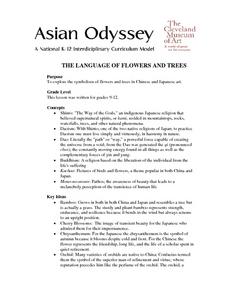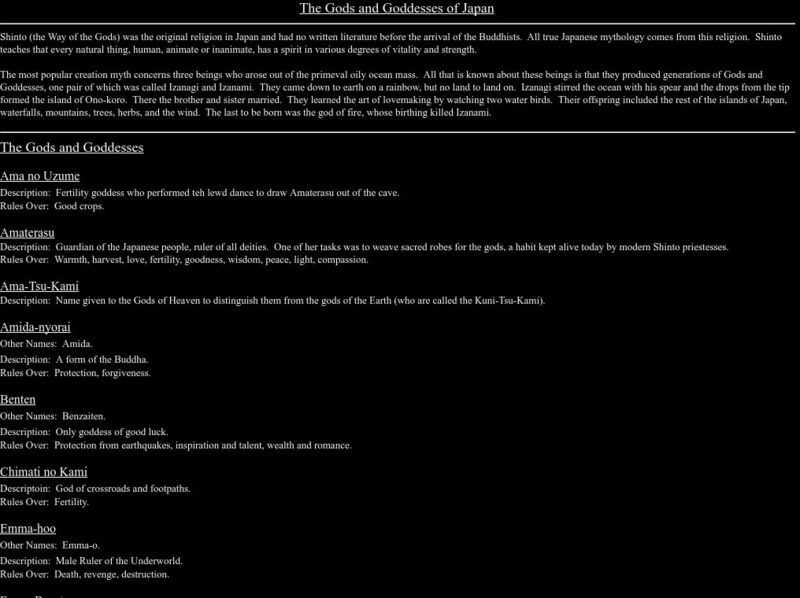Curated OER
Haniwa
Students use non-fired clay and posterboards to create and display examples of Haniwa and kofun in this exciting lesson for the Social Studies, Humanities, Asian Studies, or Art classroom.
Curated OER
The Four Religions of East Asia
Students compare and contrast the four main religions of Asia (Buddhism
Confucianism, Daoism, and Shinto). This lesson is intended for use in the middle school Social Studies classroom.
Curated OER
The Tale of the Mandarin Ducks
Students are introduced to the time of the samurai warriors using the guided reading of "The Tale of the Mandarin Ducks". The teacher reads the story to the students and they make connections from the text about the history of the samurai.
Curated OER
Religions
Eighth graders explore the major religions of the world. For this religion lesson, 8th graders create a foldable with the characteristics of the religions to study. Students watch videos, PowerPoint slides and look at pictures from the...
Curated OER
Vocab-u-lous! Build a Fabulous Vocab: Thanksgiving
For this Thanksgiving vocabulary worksheet, students select the best choice to complete the sentence about Thanksgiving. The worksheet challenges students with complex words.
Curated OER
Comparative religious Teachings
Ninth graders examine the goods and culture that was traded along the Silk Road. For this World History lesson, 9th graders compare and contrast the belief systems of the Silk Roads. Students analyze a primary text of sacred and...
Curated OER
The Golden Rule of Reciprocity
Students explore The Golden Rule of Reciprocity from various religions. In this religious beliefs lesson, students examine various religious quotes and summarize the idea of The Golden Rule in a sentence.
Curated OER
Animals in Art
Students look at how animals are shown in literature and art as representing emotions, telling a story, or sending a message in this elementary school Language Arts and Visual Arts lesson.
Curated OER
The Language of Flowers And Trees
High schoolers explore the symbolism of flowers and trees in Chinese and Japanese art. This lesson meets state standards and includes two possible lesson extensions or lesson enrichments.
Curated OER
"He Says, She Says"
Stuents compare and contrast male and female views of love and beauty in classic Chinese and Japanese society through the reading and evaluation of prose and poetry. Chinese and Japanese art is also studied.
Curated OER
Flora, Fauna, and the Passing Seasons
Students discover representations in art, religion and cultural practices of the flora and fauna of specific geographical regions in this early elementary lesson plan. The instructional activity ends with a mural project by the entire...
Curated OER
"For The Birds" [part II]
Students examine how Chinese and Japanese artists used different kinds of birds
as representations of ideas that were important in both cultures and create their own birds using the technique of origami.
Curated OER
Belief Systems of the Silk Roads
Students review, compare, and contrast belief systems of the Silk Roads. They analyze primary texts of sacred and philosophical writings. Finally, students recognize the rich diversity of belief systems along the Silk Roads.
Other
Japan National Tourism: Japanese Shinto Shrines
Japan's indigenous religion is known as Shinto. Here is a brief look at it with hand drawn illustrations of the shrines, costumes, and masks accompanying the text.
Library of Congress
Loc: Country Studies: Japan [Pdf]
A wonderful resource on Japan can be found here. It provides an in-depth study of the history of the country, their society and culture, education and arts, economy, relations with other nations, politics, national security, and much...
Other
Scns: The Gods and Goddesses of Japan
List and description of Gods and Goddesses of ancient Japanese history.
Khan Academy
Khan Academy: Female Shinto Spirit
This figure represents a Shinto goddess; her name is not known. She is depicted as an aristocratic woman, dressed in a thick kimono-like garment. Shinto images like this one were not meant to be seen but were kept hidden in movable...
Khan Academy
Khan Academy: Female Shinto Spirit
This figure represents a Shinto goddess. Shinto images like this one were not meant to be seen but were kept hidden in movable cabinets in a special part of shrines, where they were privately worshiped. View a picture of this figure and...
Curated OER
Guide to Japan: Shinto
This site contains descriptive information about the Japanese religion Shinto and its history.
Curated OER
Guide to Japan: Shinto
This site contains descriptive information about the Japanese religion Shinto and its history.
Curated OER
Guide to Japan: Shinto
This site contains descriptive information about the Japanese religion Shinto and its history.
Other
Japan guide.com: Religion in Japan
Provides links to information on the two primary religions of Japan--Shintoism and Buddhism--and to its various minority religions, including Confucianism, Christianity, and Islam. Includes useful facts about Japanese wedding practices,...
Khan Academy
Khan Academy: Archery Practice
Under a cherry tree in full bloom, a mounted archer takes aim at a round paper target held by a running servant. One of several forms of archery practice formalized as early as the Kamakura period (1185-1333), this activity trained...
National Earth Science Teachers Association
Windows to the Universe: Tsuki Yomi
Use this essay from the Windows to the Universe to learn more about Japanese mythology. "Tsuki-Yomi was the Moon god according the oldest Japanese religion, Shinto, which means 'the way of the gods.'"













!["For The Birds" [part II] Lesson Plan "For The Birds" [part II] Lesson Plan](http://content.lessonplanet.com/resources/thumbnails/122476/large/cgrmlwnvbnzlcnqymdeymtaxny0yoda5lwu0ew85zi5qcgc.jpg?1414222640)


![Loc: Country Studies: Japan [Pdf] Website Loc: Country Studies: Japan [Pdf] Website](http://content.lessonplanet.com/resources/thumbnails/409983/large/bwluav9tywdpy2symdiwmduymc0xmzc2my0xzxkzztu2lmpwzw.jpg?1589982849)





